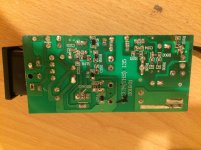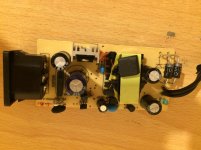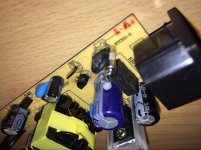a power adapter for me is more simple for me .. over amperage doesn't hurt the device? if i hook it to a for example a 10amp but it actually needs 5amp will it work safely?
It will work safely.
It is the car receiver that will decide how much current is drawn, not the power supply.
Buying a power supply rated greater than 5 A will leave a safety margin in case of momentary current demands greater than 5 A from the receiver.
It is the car receiver that will decide how much current is drawn, not the power supply.
Buying a power supply rated greater than 5 A will leave a safety margin in case of momentary current demands greater than 5 A from the receiver.
@galu, if you please, i want to learn about this subject to understand it well, about controlling the amount of current drawn and the current supplied, how the receiver decides how much current is drawn? how it happens? if it's a large topic please if you have a reference or link i can read it or watch it
Burnt due to overload.
End of mystery.
Some car sets need 13 volts, and here linear as well as SMPS are available.
SMPS noise may be an issue...
End of mystery.
Some car sets need 13 volts, and here linear as well as SMPS are available.
SMPS noise may be an issue...
Simple, the louder you play the receiver, the more current it will draw from th e supply.@galu... how the receiver decides how much current is drawn?
a power adapter for me is more simple for me .. over amperage doesn't hurt the device? if i hook it to a for example a 10amp but it actually needs 5amp will it work safely?
NEVER use too high voltage!!! A higher Ampere rating does not hurt. It hurts the other way around like by feeding a 5A load with a 2.5A SMPS.
ok 🙂
@NareshBrd, the psu burnt as i turned on the electricity , there was nothing connected to it .. i was just trying it as it has a led on it, it immediately burnt, i think maybe internally the polarity was connected in reverse, negative on positive and positive on negative, i was advised as it's from china to check the polarity of it's wiring as it seems to be happened with others but i don't have a multimeter and gave it a try so it happened lol
@NareshBrd, the psu burnt as i turned on the electricity , there was nothing connected to it .. i was just trying it as it has a led on it, it immediately burnt, i think maybe internally the polarity was connected in reverse, negative on positive and positive on negative, i was advised as it's from china to check the polarity of it's wiring as it seems to be happened with others but i don't have a multimeter and gave it a try so it happened lol
Now buy a good one.i've got it for cheap from aliexpress with free shipping
JUnk the burnt one.
You can´t repair it, period:
* you don´t even have a multimeter
* you don´t know what to measure
* you don´t have a schematic
* the device is incredibly cheap (hint: cheaper than repairing)
* did I say the Magic Word?: "disposable"
* it even burnt on its own, WITHOUT load!!!!!
It seems to me to be a cheap blocking oscillator. I see few components over the board, so I suppose that several SMD devices under the board are also blown. If you have at hand the label with the ratings of the stuff, perhaps you can find another with similar properties to repace it.
The failure mode of the first post power adapter is due to a design fault. Input filter is missing, primary side filter capacitors have a high ESR, and the main power mosfet and/or bridge rectifier don't have the required voltage safety margin. If the wall plug contacts are dirty or the power cord is not plugged in firmly, the small arcing due to the initial high current draw will cause a voltage spike on the power mosfet supply rail. This ensures the destruction of the mosfet, the semiconductors connected to the gate of the mosfet and also the low ohmic value power resistor. This part is meant to work as a makeshift fuse, since the real fuse on the input is usually a slow-blow type with excessive rating. The design is not compliant with UL and CE regulations, but unfortunately i've seen it often inside cheap power supplies that don't have a recognizable manufacturer or have a fake label. My first advice to friends that find this type of supplies inside a direct China import package is not to use them. The second advice is to discard them, really. But if they "must" use them, the only way to pospone the demise is to never ever turn off and unplug. The only part that is worth saving may be the plastic enclosoure with the mains connector. I once fitted a DC blocker circuit inside one of these.
Last edited:
....burnt as i plugged it to wall socket, it was new, the first time plugged to wall...
Seems like the factory and seller didn't even test these before shipping. Which may tell you how much they care.
yes, for sorrow, although the build quality look so good and the components on the board are very sturdy doesn't wobble and are not messy, looks like a quality thing other than some good adapters i've seen before .. i'll just throw it away avoiding using any of its components that may are defected, i'll just keep the cables and the heatsink and the connector .. someday i should get a multimeter
Attachments
The 'ceramic capacitor' looks like a Thermistor. NTC = negative temperature coefficient.
Can't make the other out. If it is in series with one of the mains input lines then it will be a fuse.
Fuses like that are not to protect circuitry, they are to protect the user. Semiconductors fail many many times faster than it takes a fuse to blow.
Can't make the other out. If it is in series with one of the mains input lines then it will be a fuse.
Fuses like that are not to protect circuitry, they are to protect the user. Semiconductors fail many many times faster than it takes a fuse to blow.
Alarm buzzer and red LED now activate. Please don't do anything to this PSU if you lack knowledge. Members giving advices based on their knowledge and experience is well meant but it really would be best to not attempt repair.
Last edited:
how protect a user, what it do
It would prevent a catastrophic current flow that could start a fire.
The current needed to blow those components apart is actually pretty small, way below what a mains fuse would pass.
- Home
- Amplifiers
- Power Supplies
- my power-adapter burnt as i plugged it to wall socket


